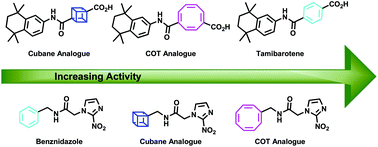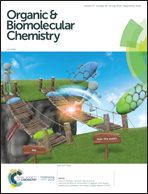The cubane paradigm in bioactive molecule discovery: further scope, limitations and the cyclooctatetraene complement†‡
Abstract
The cubane phenyl ring bioisostere paradigm was further explored in an extensive study covering a wide range of pharmaceutical and agrochemical templates, which included antibiotics (cefaclor, penicillin G) and antihistamine (diphenhydramine), a smooth muscle relaxant (alverine), an anaesthetic (ketamine), an agrochemical instecticide (triflumuron), an antiparasitic (benznidazole) and an anticancer agent (tamibarotene). This investigation highlights the scope and limitations of incorporating cubane into bioactive molecule discovery, both in terms of synthetic compatibility and physical property matching. Cubane maintained bioisosterism in the case of the Chagas disease antiparasitic benznidazole, although it was less active in the case of the anticancer agent (tamibarotenne). Application of the cyclooctatetraene (COT) (bio)motif complement was found to optimize benznidazole relative to the benzene parent, and augmented anticancer activity relative to the cubane analogue in the case of tamibarotene. Like all bioisosteres, scaffolds and biomotifs, however, there are limitations (e.g. synthetic implementation), and these have been specifically highlighted herein using failed examples. A summary of all templates prepared to date by our group that were biologically evaluated strongly supports the concept that cubane is a valuable tool in bioactive molecule discovery and COT is a viable complement.

- This article is part of the themed collection: Synthetic methodology in OBC


 Please wait while we load your content...
Please wait while we load your content...